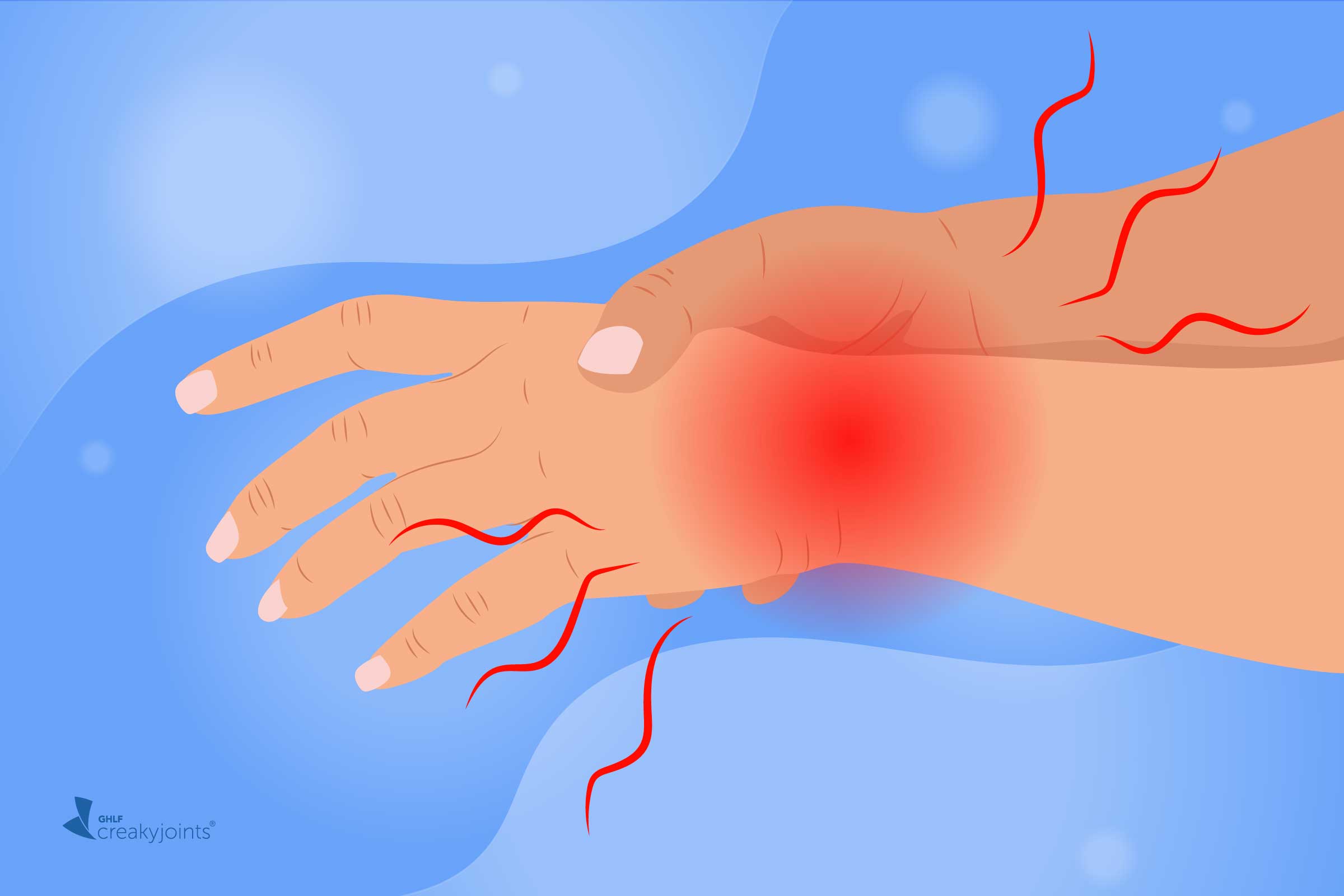

For some people with disabilities, getting a handicap parking permit is a no-brainer. For others, the decision can be hard to accept. You might not be sure if you qualify for disability parking, how to apply, or — for those with invisible disabilities — if you’re going to get comments and stares from strangers. But having a handicap parking permit can allow you greater freedom to live your life. “I got an accessible parking placard years ago because it meant I could do more with the energy I have, rather than unnecessarily using it on standing in the grocery line and then collapsing over the long walk to a car,” Charis Hill told us on Facebook.
We talked to doctors and people with different types of arthritis to find out what you need to know about this process.
A note on language we use in this article: It’s common to see parking spots marked with the International Symbol of Accessibility (ISA) — the icon of a person in a wheelchair — referred to as “handicap parking.” But there’s been a move away from using the word “handicapped” to “person with a disability” and from “disabled parking” to “accessible parking.” For the purpose of this article, we may use them interchangeably when quoting others or referencing state motor vehicle agencies. The placards themselves may say “authorized parking,” “disabled person parking placard,” or simply feature the ISA.
Eligibility for an Accessible Parking Placard
Having a permanent (usually blue) placard that you hang in your car windshield lets you park in spots marked with an ISA. States also allow placards for a temporary or short-term disability, such as after having surgery. The allowances for who is eligible can vary by state. The application and registration process is usually done through the state’s Department of Motor Vehicles (or the state’s equivalent).
See below for links to resources for your state.
“For example, New York makes clear its rules for who may obtain the placard,” says Theodore R. Fields, MD, FACP, a rheumatologist at Hospital for Special Surgery (HSS) in New York City. “Some of the Department of Motor Vehicles’ list of disabilities that qualify for the placard and which especially relate to people with arthritis are: inability to walk 200 feet without stopping and severe limitation in the ability to walk due to an arthritic, neurological, or orthopedic condition.”
Most states have similar requirements, although exactly how the placards are used may be slightly different. Some states, such as New Jersey, may require the holder of the permit to carry a special ID card, which you get when you apply for the placard, as proof you can use it. Some states, like Texas and California, let holders park for free in metered parking. Others, like Illinois, have enacted additional requirements for utilizing free metered parking, such as an inability to manipulate coins due to fine motor issues in both hands.
License plates marked with the ISA are also available, but the main advantage to having a placard rather than a license plate is that you can bring the placard with you from vehicle to vehicle. You don’t have to be driving as long as you are riding in the car. Some states, such as New Jersey, allow you to apply for both the placard and license plate at the same time.
Keep in mind that you are the only one legally permitted to use the placard to park in a spot labeled for disabled people. If you are not in the car as a driver or passenger, other people are not allowed to use the placard.
How to Apply for a Handicap Parking Placard
States’ policies may vary slightly. Many let you obtain and print out applications online, and then mail them in or bring them to your local motor vehicle office. Most states require your doctor to sign a form to authorize that you qualify for disabled parking. Some, such as California, allow exceptions if you’ve lost a leg or both hands and apply in person.
“Go to your state’s department of motor vehicles website and download the handicap placard application,” says rheumatologist Grace Hsiao-Wei Lo, MD, an assistant professor of medicine in the section of immunology, allergy, and rheumatology at Baylor College of Medicine in Houston. “Review the application to see if you think you might be eligible; if so, make an appointment with your doctor.”
Talking to Your Doctor About Getting a Handicap Parking Placard
For some people, broaching the subject of handicap parking permits with the doctor can feel daunting. “It was a difficult decision for me to ask my doctor for the paperwork to get my handicap parking permit,” Beth McDonald Quarterman told us on Facebook. “I brought it up and my wonderful doctor just took it immediately from there, thankfully. He knew how hard it was for me to ask.”
Dr. Fields says people should be comfortable bringing up this issue with their doctor, even if that conversation means you learn you don’t yet meet the requirements. “There’s no penalty for discussing this question,” Dr. Lo says. “The worst thing that happens is that a patient is not eligible for the handicap placard.”
Be sure to let your doctor know about all your symptoms and how your disease is affecting you; only then can they tell whether you may qualify. “Bringing up this request early on in the appointment is important, so that you have enough time to be evaluated by your doctor,” says Juliette Kleinman, LCSW, ACSW, a senior social work manager in rheumatology at HSS.
On the other hand, sometimes your doctor will first broach the idea of your getting an accessible parking placard. Remember it’s ultimately your call. “My rheumatologist gave me the paperwork completed when he said that it was time, but mentally I’m not there,” Barbara Tanner Jordan Anderson told us on Facebook. Applying for the permit should be a joint decision between you and your doctor. “It is only really useful if a patient is emotionally ready to use it,” Dr. Lo says.
Why You Should Consider a Handicap Parking Placard
You may think getting an accessible parking placard signals a change in your identity, and this is understandably difficult. “I nearly cried,” Ryan Hope Fitzgerald told us on FB about getting the placard.
“Each patient has different emotions associated with the placard,” Dr. Lo says. “Some patients might feel self-conscious by using a handicap placard, thinking it indicates that they are less independent.”
Putting off getting it, though, may mean the pain and fatigue of arthritis reduces your ability to navigate daily life. “These changes may cause barriers getting to necessary medical appointments; completing your daily activities like work, shopping, and attending social or family events; and affect your emotional well-being,” Kleinman says. “Having a handicap placard can help you find parking that is closer to what you need to do, helping you to continue to be independent and socially connected.”
Think of the placard as added support in managing your condition, she says, especially if you find yourself avoiding activities because parking is too far away.
Most CreakyJoints members we heard from agreed that instead of making them feel disabled or less independent, the placard actually helped them be more independent and mobile. “I found that having to walk across a parking lot every time I needed anything was preventing me from going out, so it’s been a complete lifesaver,” Hannah Mary told us.
“Maintaining as much independence as you can is important to your physical and emotional well-being,” Kleinman says.
For People Who Wonder: ‘Do I Really Need It?’
Some arthritis patients may feel that others need the accessible parking spot more than they do — and that’s OK, because there’s no rule that you have to use your placard if you’re having a good day.
“Having a handicap placard doesn’t mean that a patient can’t park in a regular parking spot,” Dr. Lo says. “It just means that if he or she feels the need, he or she can part in the handicap spot. The placard provides more options in the event that the patient is not doing or feeling so well on a particular day.”
The people we heard from affirmed that even when they don’t use their placard, it gives them more confidence to go more places. “I don’t always need it, and when I don’t, I park as usual,” Christina Ames told us.
Remember though, that even if you feel good going in to a store, you might feel like crawling out, especially if you’re going to be on your feet for a long period of time, such as while grocery shopping. So it’s best to plan ahead. “I don’t always limp when I get out of my car, but I still need to park close by because I’m always in pain and limping when I leave,” Roselyn Gibson-Tolliver told us. (Watch Roz’s story about living with ankylosing spondylitis here.)
Coping with Invisible Illness Stigma and Handicap Parking
“There are a number of conditions where a patient’s source of disability is not visible to an observer,” Dr. Fields says, including many cases of arthritis. “The key issue is how these issues are affecting the patient rather than how they look to others.”
Fatigue, for example, can be a reason you can’t walk 200 feet without stopping; even inflamed or damaged joints aren’t necessarily noticeable to others.
Unfortunately, this invisibility may mean others mistakenly think that people with arthritis or other kinds of chronic illness are abusing disabled parking spots.
“I have gotten dirty looks, mean notes on my car, and people telling me that I should be ashamed of myself,” Kimberly Delaney told us on FB. Although these comments are born out of ignorance, there are a few ways to handle them — including not handling them at all. “If people are judging me, I don’t notice nor do I care,” Pamela Middaugh Jones wrote.
Or you could use those moments as an opportunity to educate, such as printing out a sign that says, “Not all disabilities are visible,” and putting it in your car window. Although you should take caution with confrontation, some CreakyJoints members also suggested some witty comebacks.
“My husband said if anyone should say anything, I should respond, ‘I have medical conditions that cause severe pain and weakness. Would you like to trade with me?’” DS George-Jones told us.
However you choose to address any stigma you encounter over using an accessible placard for your invisible illness, it’s really nobody’s business but yours and your doctor’s.
“The pain and fatigue from arthritis is internal and may not be visible to others, however, you are the one who experiences it day to day,” Kleinman says. “It’s understandable that we may be concerned about what others think, but remember, the handicap placard is there to help you take care of yourself and get you to where you need to be to maintain your independence.”
A List of State-by-State Resources
- Alaska
- Alabama
- Arkansas
- Arizona
- California
- Colorado
- Connecticut
- Delaware
- Florida
- Georgia
- Hawaii
- Idaho
- Iowa
- Illinois
- Indiana
- Kansas
- Kentucky
- Louisiana
- Massachusetts
- Maryland
- Maine
- Michigan
- Minnesota
- Missouri
- Mississippi
- Montana
- Nebraska
- Nevada
- New Hampshire
- New Jersey
- New Mexico
- New York
- North Carolina
- North Dakota
- Ohio
- Oklahoma
- Oregon
- Pennsylvania
- Rhode Island
- South Carolina
- South Dakota
- Tennessee
- Texas
- Utah
- Virginia
- Vermont
- Washington
- Washington, DC
- Wisconsin
- West Virginia
- Wyoming
Keep Reading
Subscribe to CreakyJoints
Get the latest arthritis news in your inbox. Sign up for CreakyJoints and hear about the latest research updates and medical news that could affect you.





